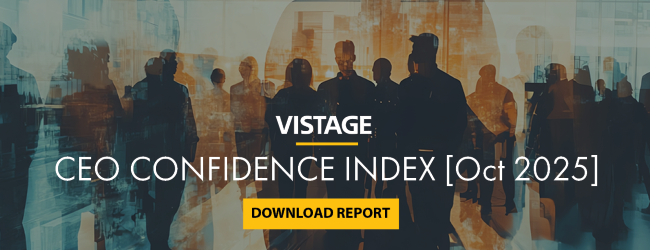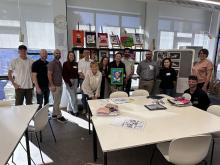

Australian CEOs are showing a modest lift in optimism heading into 2026. The latest Vistage CEO Confidence Index (October 2025) reveals a slight rebound in business sentiment, supported by stronger consumer spending and recent interest rate cuts.
The Reserve Bank of Australia’s third rate cut in August has provided some relief for business. Many leaders report improved customer confidence and cash flow. However, inflation remains stubborn, dampening expectations of further easing.
Among the 122 CEOs surveyed, 28 per cent expect economic conditions to improve in the year ahead, up from 20 per cent in June, while 30 per cent expect them to worsen. This near-even split underscores a fragile recovery and the pressure many leaders still face as they plan for 2026.
A Fragile but Firming Outlook
Economic growth improved to 0.6 per cent in the June quarter, up 1.3 per cent for the financial year. While welcome, it remains one of the weakest growth periods since the early 1990s (excluding the pandemic).
Vistage respondents reflected this pattern: fewer CEOs said conditions had worsened, and a small rise in those saw improvement. “We’re seeing a bit more confidence that the corner has been turned,” said one B2B leader. Others cited “a modest increase in customer demand” and renewed investment confidence.
Still, most CEOs are navigating persistent cost and wage pressures while adapting to a slower, more competitive environment.
Hiring Holds Firm Amid Skills Shortages
Confidence in individual business performance remains stronger than in the broader economy. Two-thirds of CEOs expect revenue to increase over the next 12 months, and just over half anticipate higher profitability. Nearly half (49 per cent) plan to increase their workforce, though this is slightly lower than last quarter.
The labour market remains tight. Unemployment has edged up to 4.5 per cent yet demand for skilled staff continues to outpace supply. Sixty-seven per cent of CEOs said technical and specialist roles are hardest to fill, followed by leadership and management positions (20 per cent) and digital or AI skills (11 per cent).
The skills gap continues to constrain growth. As one respondent noted, “Finding suitable staff remains our biggest challenge.”
Engagement Becomes a Performance Driver
This quarter’s Index focused on Talent and Engagement, highlighting a shift in how leaders view their people. Engagement is increasingly seen as a business performance indicator rather than a HR function.
Many CEOs are tracking engagement through multiple measures:
- 69 per cent conduct employee surveys
- 57 per cent rely on one-on-one manager check-ins
- 36 per cent assess productivity and performance metrics
- 35 per cent track retention rates
When asked what drives engagement most, 51 per cent cited a positive, values-driven culture, 44 per cent emphasised communication and transparency, and 33 per cent identified recognition and appreciation as key to retention.
As one CEO put it: “Engagement isn’t a survey result; it’s how we communicate, lead, and make people feel seen every day.”
Culture as a Competitive Advantage
With 98 per cent of leaders reporting difficulty sourcing key skills, many are investing in leadership development, career pathing, and mentoring programs to build capability and retention.
More than two-thirds of CEOs now integrate engagement metrics into their broader business dashboards, monitoring them alongside operational and financial KPIs. This data-led approach allows leaders to detect early signs of disengagement and act quickly.
Middle managers are increasingly being trained to interpret engagement data and hold effective one-on-one conversations, building depth in leadership capability, a key differentiator in a tight labour market.
ESG and Efficiency on the Agenda
Sustainability also featured in the October survey. Forty-two per cent of CEOs said their business has an active ESG policy, while another 26 per cent are developing one. More than half have taken steps to reduce energy costs, most commonly through solar adoption and electric vehicle transitions.
One industrial CEO reported achieving net-zero operations this year through solar installation and efficiency upgrades, cutting both emissions and energy costs.
Looking Ahead
The October 2025 Vistage CEO Confidence Index paints a picture of guarded optimism. The economy is showing tentative improvement, but inflation, cost pressures, and skills shortages continue to weigh on sentiment.
Despite these headwinds, Australia’s CEOs remain focused on growth, investing in culture, leadership, and sustainability to strengthen performance.
As the economy adjusts to new interest rate settings and shifting global conditions, one message stands out: confidence begins with capability. Leaders who prioritise engagement, build depth in their teams, and adapt with agility will be best placed to thrive in 2026 and beyond.












